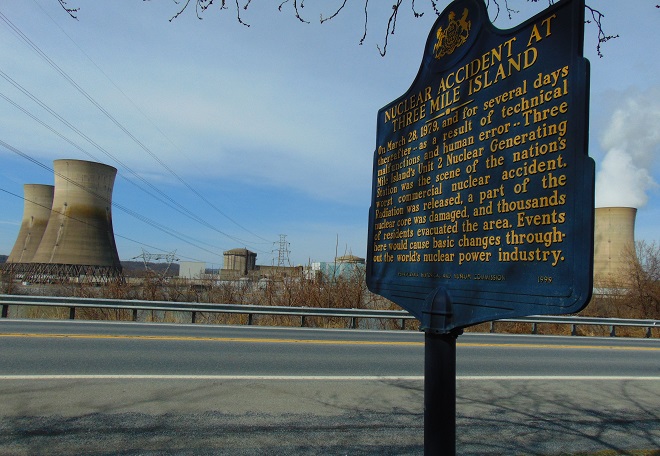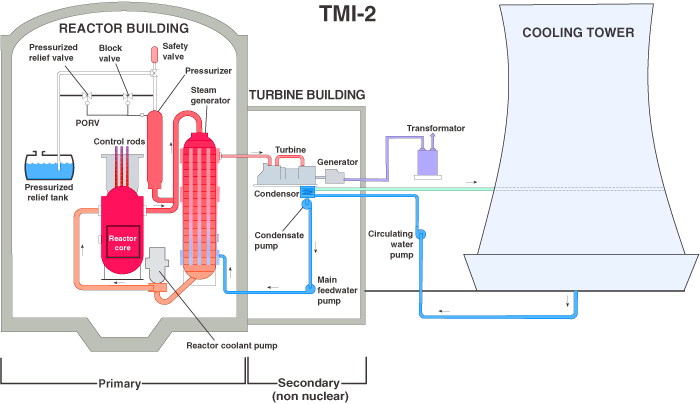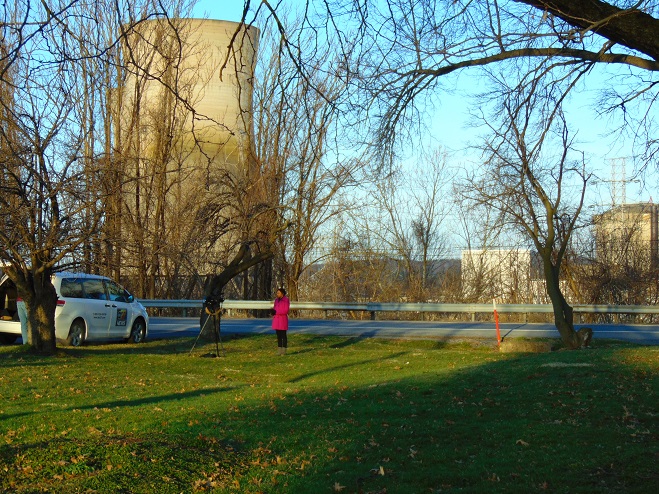
Forty years ago, at just about 4:01 A.M. on Wednesday, March 28, 1979, the Unit 2 reactor at the Three Mile Island Nuclear Generating Station on the Susquehanna River at Conewago Falls “scrammed”—the control rods automatically dropped into the reactor core to stop fission. This occurred in response to the automatic opening of the “Pilot-Operated Relief Valve” (P.O.R.V.) on the pressurizer, a tank designed to prevent the boiling of water in the primary cooling system loop that transfers heat energy from the reactor core to the steam generator. The P.O.R.V. activated when steam in the top of the pressurizer tank was compressed by water that was expanding as it increased in temperature while circulating within the primary cooling system loop.
During normal operating conditions, water in a non-nuclear “secondary loop” is pumped through tubes within the steam generator where it absorbs energy from the hot water in the primary cooling system loop. The heat converts the water in the “secondary loop” to steam for turning the steam turbine and making electricity. At about 36 seconds after 4:00 A.M., a set of pumps “tripped” and stopped feeding water through the “secondary loop” to the steam generator. Within seconds, Unit 2 ceased making electricity. Starting automatically as a failsafe were a set of three “emergency feedwater pumps”, designed to reestablish water flow to the steam generator. A reactor operator verified their start just fourteen seconds after the main pumps “tripped”. Unfortunately, the operator did not notice the panel lights indicating that valves were closed on each of the two lines supplying the steam generator from the emergency pumps. With the “secondary loop” shut down, heat from fission in the reactor core began accumulating within the steam generator and the primary cooling system loop, leading to the P.O.R.V. activation, and the reactor’s “scramming”. The “scram” triggered control rods to drop in 69 tubes among the 36,816 uranium oxide fuel rods to absorb neutrons and stop the chain reaction fission process in the core of Unit 2.

Following the reactor’s “scramming”, an equipment malfunction occurred when the P.O.R.V. failed to automatically close as designed after reducing pressure within the pressurizer vessel on the primary cooling system loop. Unbeknownst to anyone at the time, this equipment malfunction initiated a small “Loss Of Coolant Accident” (L.O.C.A.). Fortunately, the reactor’s High Pressure Injection system (H.P.I.) automatically began pumping water into the primary cooling system to compensate for the loss of coolant through the stuck valve. Even though fission was no longer generating heat, the decaying radioactive materials within the reactor still require continuous cooling until the reactor is brought to cold shutdown.
(Note that the dropping of control rods to effect an automatic scramming immediately reduced the heat output in the core to 160 megawatts, or about 6% of that generated while the fission reaction was occurring. Normally, the heat release rate after the first hour would drop to about 30 megawatts and, over next three hours, to 20 megawatts. This is still a lot of heat—enough to severely damage the fuel assemblies in the core. Twenty megawatts is equivalent to the heat release rate from a big wind-driven apartment fire. It is critical that an uninterrupted flow of cooling water circulates through the core to prevent damage. See the “Riverside Firemen’s Retreat” page on this site to learn how heat release rate applies to the work firefighters do.)
Enter human error, enhanced by insufficient training, missing protocols, and a poorly designed control panel (including, at one point, 100 alarms in simultaneous operation!), and soon the small L.O.C.A. was converted into a destructive meltdown event. An illuminated light on the reactor control panel indicated that a signal had been sent to close the stuck P.O.R.V.; it did not indicate the valve’s position—open or closed. It would be two hours before operators were aware of the stuck valve and would take corrective action to close the back-up “block valve” to stop the leak. Had the H.P.I. system continued operating autonomously throughout this two hour period, no damage to the reactor core would have resulted. However, operators began overriding the emergency H.P.I. system by throttling the flow of 1,000 gallons per minute back to less than 100, hoping to maintain a certain water level in the reactor. This action was inspired by an operator’s doctrine encouraging them not to let the primary cooling system ever “go solid” (fill completely with water). For “extended periods” during the first day of the event, the H.P.I. was throttled back or shut down. It was during these periods that much of the core of the reactor was exposed, resulting in its meltdown.

The Report of the President’s Commission on the Accident at Three Mile Island reveals how haphazard and unorganized the notifications of key persons and agencies were from the very start of the accident. The mayor of Harrisburg at the time, Paul Doutrich, first heard about the accident when he received a phone call from a radio station in Boston inquiring what he planned to do about the nuclear emergency. They had to fill him in first.
The public gained little if any confidence from clumsy and often contradictory public statements made by the plant operator, regulators, and various other government officials during the first days of the event. The oscillations between dire warnings on one hand, and assurances that there is no need to worry on the other, frightened and angered thousands of people in 1979. Memories of these awkward and inconsistent messages continue to be the dominant recollections for many residents of the lower Susquehanna region to this very day.
Here, for your entertainment pleasure, is how the media and general public first learned of the accident on the morning of March 28, 1979 (quoted from the Report of the President’s Commission on the Accident at Three Mile Island)…
“WKBO, a Harrisburg “Top 40” music station, broke the story of TMI-2 on its 8:25 a.m. newscast. The station’s traffic reporter, known as Captain Dave, uses an automobile equipped with a C.B. radio to gather his information. At about 8:00 a.m., he heard police and fire fighters were mobilizing in Middletown and relayed this to his station. Mike Pintek, WKBO’s news director, called Three Mile Island and asked for a public relations official. He was connected instead with the control room to a man who told him: “I can’t talk now, we’ve got a problem.” The man denied that “there are any fire engines,” and told Pintek to telephone Met Ed’s headquarters in Reading, Pennsylvania.”
By late Wednesday afternoon, the reports from the plant indicated that everything was under control. Day one would end with the residents of the lower Susquehanna area presuming they would hear little more of this event. Then came Friday.
SOURCES
Forman, Paul, and Sherman, Roger. 2004. Three Mile Island: The Inside Story. Web presentation based upon Smithsonian National Museum of American History exhibit, as accessed March 28, 2019. https://americanhistory.si.edu/tmi/index.htm
Kemeny, John G., et al. 1979. Report of the President’s Commission on the Accident at Three Mile Island; The Need for Change: The Legacy of TMI. U. S. Government Printing Office. Washington, D.C.
